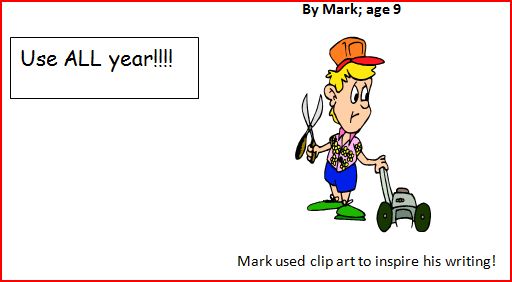It's time to enhance descriptive writing with visual art. Try this K3 lesson:
Materials you need would be small pictures of animals/ people, places or things, colored pencil/crayons, white paper, construction paper, lined paper or worksheet, pencil, glue and scissors.
Elaborated Sentences (example)
The short landscaper couldn't decide whether to trim the bushy hedges or mow the tall green grass today. Age 9
Lesson:
When using nouns, verbs and adjectives, it is motivating to give the children pre-drawn pictures of animals, people, places or things to color and describe once a week; ages 5-9 (Note: Younger children may need to dictate their elaborated sentences.)
- Locate pictures to color and describe in an elaborated sentence (i.e. dogs, cats, fish, insects, people etc.)
- Pre-draw the visual(s) or allow the children to illustrate their own detailed pictures; a background is optional. If time is a challenge, select actual photographs for kids to use rather than illustrate. Clip art is a fun and easy way to solve this problem and expedite the lesson. Just use clip art; a small visual for each sentence. Sculptures are fun to use too. (See other ways to use this lesson).
- Remind the children to add colorful details to their pictures. This will enable them to have more to write, descriptively.
- Allow each child to write a descriptive sentence telling what the “subject” or “noun” looks like and what it is doing and “where”.
- The fluffy cat is soaring in the warm blue sky in my backyard.
adjective noun verb place……. where?….
- Remind the children to use the verb to describe the action. Sometimes it is easier to tell them to use doing words: verbs with ‘ing.’ You decide what suffixes to include: ly, es, ed etc.
- In order to reinforce the use of verbs (if this is your ‘skill’ focus), have each child circle the verb. You can do this for nouns and adjectives as well. Have fun and change the colors for each word circled. You will be amazed how well your students will elaborate their thoughts.
- Lastly, remember that any visual or object can inspire elaborative writing, so be creative and allow your children to practice weekly.
Evaluation:
Depending on the skill you are reinforcing, this activity lends itself easily to assessing descriptive sentences, elaborative sentences (answering: who, what, where, why, when, and how), and use of adjectives, verbs and nouns. Be sure to inform your students about your expectations. Perhaps you can orally assess a particular skill by asking the children to tell you to name the verbs, or nouns and adjectives. Their written application will already be completed. Another way to organize your anecdotal notes can be to create a skill chart and check off the skills that have been mastered or need more improvement.
Other Ways to Use This Lesson:
Remember to allow the opportunity for your learners to write “visually”. Let them see the picture before they write. Train them early to ‘visualize’ and see the details. Guaranteed, your students will feel more confident with this approach.
As stated earlier, this lesson can focus on one skill at a time. When you are introducing “verbs” or action words, decide which kind of verb you want them to use and circle those words in their descriptive sentence. The children can use 3 pictures or clip art and compare “verbs” to match/describe the action with each. You can try present and past verbs too. List the words and create a verb list or verb pictorial dictionary. This activity can give you an on-going assessment as well. Try this activity with adjectives too.
Elaborated puppet sticks are a creative way to excite the children when they write. Children can use colored pictures, clip art, or their own art work to glue at the end of a craft stick as a puppet. Keep the puppet sticks in a basket to be reused throughout the year. Perhaps your puppet sticks are not of people or characters. Let them create scenery or object puppets too. Depending on the objective taught, if you only want to reinforce elaborative writing, allow the children to take a stick out of the basket and write a descriptive sentence. If the children want to use two puppets as characters, let them describe the puppets in an elaborative sentence while comparing the differences and similarities. The puppet is just a visual to ‘hold’. Their writing can be as creative as an elaborative poem, descriptive paragraph or narrative. Let your experienced writers stretch their imaginations and encourage them to use ‘details’.
Additionally, you can use this activity every week for practice along with reinforcing various topics throughout the year. For instance, you may be reading about birds one week, so allow the children to do a similar activity using pictures of birds. If you have stickers, try them to save time. Just illustrate the background. If time is a challenge, keep pictures or sculptures of animals/people available, with or without a background for your students to use rather than spending time illustrating. If you have time to illustrate, try stencils to trace and add details as needed.
Moreover, create a worksheet with several clip art pictures along the left side of the paper corresponding with a blank line for kids to write an elaborated sentence. Remind the children that color will help their descriptions as well. You can cut the elaborated sentences into strips, glue to construction paper and trim, laminate them and use throughout the year. If you use dry erase markers, the children can color code parts of a sentence by circling each part and simply erase when completed.
Lastly, experienced writers can keep their elaborated work in a personal journal or portfolio to be shared as the year progresses. All you need is a cover.
Check for Visual Reading and Writing Activities for the Common Core in my store.





